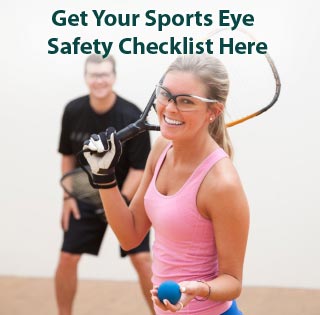With April being Sports Eye Safety awareness month, we thought it’d be appropriate to remind parents and athletes, young & old about the dangers of eye injury while participating in sports.
Sports-related eye injuries are quite common, yet the number of children who use protective eyewear (safety glasses or goggles) is extremely low. More than 600,000 eye injuries related to sports occur each year, and approximately one-third of these injuries occur in children. Only 15 percent of children reported wearing eye protection “always” or “most of the time” when participating in sports, hobbies, or other activities that could cause eye injuries. Yet, the majority of the eye injuries that occur in school-aged children are sports-related.
Eye injuries most often occur in baseball, basketball, ice hockey and racquet sports, yet few people wear protective eyewear when playing these sports. In fact, the American Academy of Ophthalmology recommends protective eyewear for any sport even for children who don’t wear glasses or contacts. Studies show that protective eyewear does not hinder the player’s sight, and some athletes even play better because they are less afraid of getting injured or hit in the eye. All athletes, even the weekend warriors, should wear protective eyewear regardless of whether or not they wear glasses or contacts.
Here are some helpful tips to protect eyesight while playing sports:
- All sports protective eyewear should meet the impact standards of the American Standards for Testing and Materials (ASTM). An optometrist can make sure that glasses and or goggles are fitted properly. There are also a wide range of polycarbonate face masks and guards that can be attached to helmets or worn by themselves.
- Everyday fashion eyewear is not held to the same protective standards as eyewear products labeled as protective eyewear for sport use. The lens in a child’s regular eyeglasses could easily pop out and puncture or cut the eye. A frame mangled from impact could also injure the eyes and ocular region of the face.
- Lenses should be made from polycarbonate materials because they provide the highest level of impact protection; they can withstand a ball or other projectiles travelling at 90-miles per hour. Polycarbonate lenses are available in both eyeglasses and sunglasses.
- Just because a sport requires a helmet or face guard, it doesn’t mean that your eyesight is protected from injuries. They are still exposed to danger from sports equipment or an opponent’s fingers penetrating the openings of a face mask. These tips apply to anyone participating in sports regardless of age.
Protective eyewear can be purchased at sporting goods stores as well as eye care professionals’ offices.


